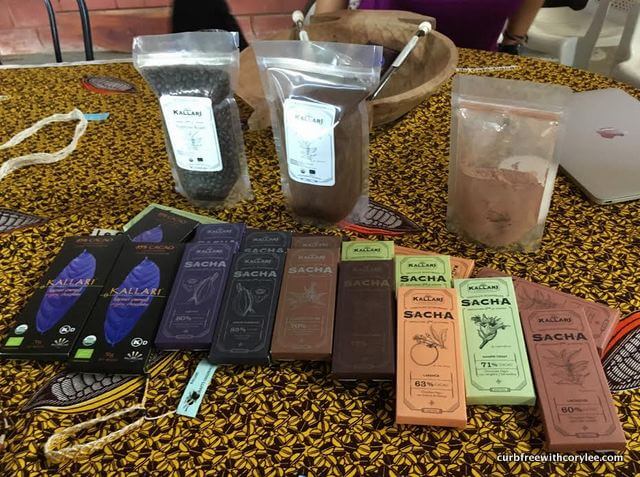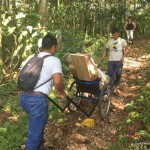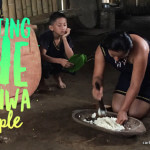My name is Cory Lee and I am a chocoholic.
For as long as I can remember, I have loved chocolate. That sweet delicious flavor just gets me every time and I can never say no to it. I eat more of it than I probably should, and I have been trying to do better, but when the opportunity to visit a cacao plantation and actually make chocolate came about in Ecuador, of course I had to do it. It isn’t every day that you get to make chocolate after all. I’ve always loved eating it, but never knew how much work goes in to creating the chocolate bars that I so frequently purchase.
The day started with a 45 minute drive from Huasquila Amazon Lodge, where we were staying, to the Kallari factory. Kallari is considered Ecuador’s best chocolate, so who better to go on a chocolate tour with than one of Kallari’s workers?! We picked up our guide from Kallari and then drove a bit further to a forest entrance. The path was smooth and I was easily able to roll in my powered wheelchair through the forest.

Almost immediately, our guide spotted a large cacao pod up in a tree. It was the National Cacao, which is the best in the country. Some other chocolate companies will use rotten cacao to make chocolate and save money, but not Kallari. They only use National Cacao and that is just one reason why they’re the best.

Me with some cacao
Our guide used a machete to chop the pod down and cut it open. Inside of it were cacao seeds. They were white and slimy. I don’t know what I was expecting the cacao seeds to look like, but it certainly wasn’t this. He asked if we wanted to try it and I said yes. I popped a seed in my mouth and sucked on it. Surprisingly, the white slimy stuff around the seed was sweet and pretty delicious with a fruit like taste. This is what all chocolate starts out as… something I never expected.

This is what’s inside the cacao
Now that we had a sweet taste of raw cacao, we explored the Amazon Rainforest some more. We saw all kinds of different plants, and even some vanilla. From medicinal plants to a variety of foods, Ecuadorians truly have everything that they could possibly want in their backyard.
After rolling around the forest for a while, I loaded back into the van and we went to a local community to finish the process of making chocolate. The house that we arrived at was actually the home of our guide’s aunt and uncle. They didn’t speak any English, but they were accommodating and welcomed us into their home with open arms. One of my favorite things about traveling is meeting and interacting with locals, and this was the perfect opportunity to do so. The house was open-air with dirt floors and just one large room, which served as the kitchen, dining area, living room, and bedroom. It wasn’t much, but they were comfortable and as happy as they could be.

The aunt was hard at work mashing up chunta.
The aunt and uncle had some dried cacao beans for us to use. After taking the white slimy seeds out of the cacao pod, you have to leave them in the sun for 4-5 days to dry out. Once they are dry, you can turn them into chocolate. We started by putting these dried cacao beans over a fire. It took about 30 minutes or so, but they finally started making a popping sound which meant that they were finished cooking.

For the next step, we had to shell them. They were extremely hot, but it was worth the risk of getting burned because with every step, we got closer to being able to eat some chocolate. Luckily, there were about six of us shelling them so it didn’t take too long. Once we were finished shelling, separating the hull from the seed, we placed them in a grinder. This process transformed the seeds into a fine brown powder and the smell of chocolate began to consume the air. Some sugar was mixed in and it was placed back over the fire to melt, turning into fondue.
Check out this short video of our chocolate adventure –
After a short while, we were ready to enjoy some fondue with our new friends. We dipped pieces of plantain and chunta (an Ecuadorian fruit) into the chocolate fondue and it was delicious. We had been working on this for a few hours, and I think that all of our hard work made the chocolate taste even better. This was hands-down the best afternoon snack I’ve ever eaten.

Eating plantain dipped in chocolate. YUM!
Unfortunately, after our fondue party it was time to say goodbye to some of our new friends. I am tremendously thankful to them for inviting us into their home and showing us some wonderful hospitality. Even though we left their house, it didn’t mean that our chocolate tasting was finished. Instead, we drove back to Kallari headquarters with our guide and sampled many of their chocolate bars.
There was an art to tasting them. We were told to take a bite and not chew it. We let it sort of dissolve in our mouths to get the full flavor. We tried 75% cacao bars, 85% cacao bars, and even one that had spicy peppers in the chocolate, just to name a few. Of course, some were better than others, but it was fun to get a taste of all of the great products that Kallari offers. Afterwards, we could purchase any that we liked. I won’t say exactly how much I spent on chocolate bars, but let’s just say that my bank account was crying by the end of my chocolate spending spree.

During the day, our guide said something that left an impact on me. He said “Inside the wrapper is not just chocolate, it is our culture”. Throughout the entire day, this was evident. I could clearly see how much chocolate meant to the people of Ecuador. It is not just a tasty snack, it’s their livelihood and they have immense pride for their world-renowned chocolate. I loved this chocolate tour and it gave me a much greater appreciation for all chocolate that I’ll eat in the future, and it also gave me a better understanding of the incredible Ecuadorian people.
*Thank you to Ecuador for All for making this experience possible! Also, this post includes affiliate links. When you click on a link, I may receive a small compensation, which will help this blog grow into a better resource for disabled travelers.








1 Comment